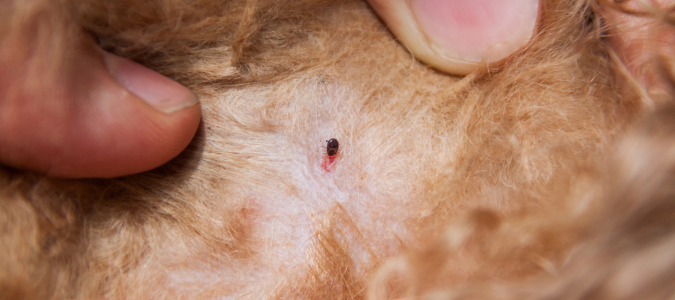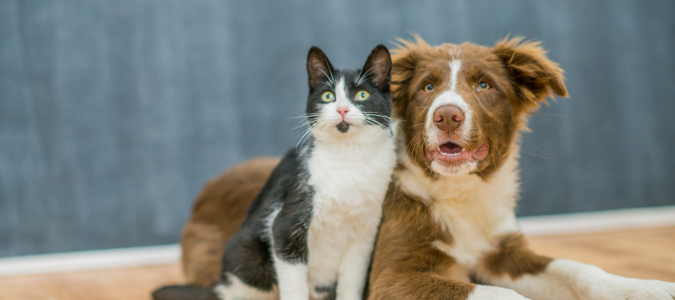Where Do Fleas Hide on Dogs?

Identifying fleas on your dog can be difficult because they are small and agile pests. It’s important to pay close attention to the areas where fleas like to hide. You may be able to spot movement or “flea dirt,” which is the feces of adult fleas.
Flea dirt is present after fleas have lived on a dog long enough to eat a blood meal. It looks like little specks of dirt and is about the size of ground pepper. It can be easy to mistake flea dirt for regular dirt. However, to tell it apart, run a damp paper towel along your dog’s fur or place a few specks of dirt directly on the towel. If the dirt turns a reddish-brown color, it’s flea dirt.
It’s also important to pay close attention to your dog’s behavior. A flea infestation will cause your dog to itch, so if you notice that your dog is scratching himself more, inspect his fur for fleas. Your dog may also bite or lick the areas that fleas have inhabited.
Dog ears are an attractive place for fleas to take up residence because they are warm and keep the fleas hidden. However, you can easily tell when your dog has fleas in their ears because they will scratch them or shake their heads back and forth out of discomfort.
Next, fleas hide in the fur along your dog’s spine. You can run your fingers along their spine and look for signs of a flea infestation, such as movement or flea dirt.
To spot fleas on the base of your dog’s tail, lift the tail and look for the pests. Lastly, fleas like to hide near your dog’s stomach because the fur is thinner, and it’s easier to access their skin for a blood meal. Gently pet your dog’s stomach to look for movement and flea dust.
If you identify fleas on your dog, it’s important to treat them to alleviate your dog’s discomfort. There are several over-the-counter flea treatments that you can use on your dog’s fur.
Additionally, contact your local pest control expert to treat your home for fleas. If your dog has fleas, they are likely in other areas of your home as well. An expert can use the best methods to control the entire flea population.

Can Humans Get Fleas From Dogs?
Once you identify fleas on your dog’s fur, it’s normal to wonder if you can also get fleas. The truth is that fleas typically live on animals. However, even though fleas prefer to live on animals, they can still bite humans.
Fleas are opportunistic feeders who will go to great lengths to find a blood meal from a warm-blooded animal, which includes humans. Additionally, fleas are skilled jumpers and can jump up to 13 inches, so they can easily jump from your dog onto your skin or another animal in your home.
Fleas typically target specific areas of human skin, including the ankles, legs, waist, arms and hands. They are attracted to areas that aren’t covered by clothes or where the skin is thinner because it is easier to access a blood meal.
If you have a pet that is infested with fleas, it’s common to find bites on your arms and hands because they come into contact with your pet’s fur the most.
How To Deal with Flea Bites
Flea bites can be incredibly irritating. They can cause redness and itching. Luckily, there are several steps you can take to alleviate discomfort from flea bites. First, wash the affected area with mild soap and water. Next, use lotion or an over-the-counter anti-itch cream to relieve the itchiness and soothe irritated skin.
The most important thing to do when you have flea bites is to avoid scratching them as much as possible. Scratching will make your symptoms worse. If you scratch in your sleep, try wearing long pants and long sleeves to cover the affected areas.
Finally, contact a pest control specialist when you discover flea bites on your body. Bites are a sure sign of a flea infestation, and working with a professional is the best way to deal with the problem in a quick and effective way.

What’s the Difference Between Cat Fleas Versus Dog Fleas?
Is there a difference between cat fleas and dog fleas? There are over 2,000 flea species; however, the most common domestic flea species is called Ctenocephalides felis, also known as the cat flea. Despite its name, this flea species infests cats, dogs and other types of animals.
Understanding their appearance, behavior and lifecycle is important for identifying fleas on cats and dogs.
Fleas are small, reddish-brown pests that have flat bodies. They’re known for jumping and moving quickly through cat and dog fur, so they can be hard to identify. Cat fleas infest cats and dogs, but as their name suggests, they prefer cats. However, when a cat is not available, they will happily take up residence on a dog, as well as other animals or humans.
In their life cycle, cat fleas go through four stages: egg, larva, pupa and adult. Adult fleas lay their eggs on animal fur. However, the flea eggs often fall off and hatch somewhere in the pet’s environment. Once they go through the larva and pupa stage and become adults, they find a host to attach to for their blood meals.
Signs of Fleas on Your Dog or Cat
Fleas can cause your dogs and cats major discomfort, so it’s important to pay attention to the signs of a flea infestation on your pet so that you can get them relief. First, fleas and flea bites are itchy, so if your pet is scratching their fur more than usual, they might have fleas.
You may also spot flea dirt on your dog and cat’s fur. Flea dirt is actually feces that contains digested blood, which is why it turns red when touched.
The last sign of a flea infestation is actually seeing the fleas on your pet’s fur. These pests are hard to detect; however, you may spot them when you run your hand along your pet’s fur.
How to Limit the Number of Fleas in Your Home
First, keep up with your pet’s grooming, including brushing their fur, which can help remove fleas and flea dirt. Next, vacuum your floors, rugs and upholstered furniture, paying close attention to areas where your pets spend time. Make sure you empty the vacuum right after using it to dispose of any fleas. Also, wash any pet beds, blankets or toys on a regular basis.
Finally, working with a pest control professional is the best way to deal with a flea infestation. The experts have the tools and experience needed to kick fleas out of your home. They can also advise you on other prevention methods to put in place to deter fleas in the future.
Get Rid of Fleas With Professional Help
Fleas are annoying pests that affect both pets and humans, so it’s important for homeowners to be vigilant about flea infestations. Pay attention to signs of a flea infestation from your pet, including scratching, biting and licking infested areas.
Along with treating your pets, you should work with a pest control professional to control a flea population in your home. Additionally, prevention methods such as grooming your pet and keeping your home clean can go a long way in deterring these unwanted pests.
Chem-Free Can Resolve Your Flea Problem
Fleas can survive long periods under a surprising range of conditions and require specialized treatment for removal. If you’re struggling with fleas in your home and want some relief without putting your family or the environment at risk, call on Chem-free. Our expert pest control technicians can identify the source of your problem and suggest low-impact intervention methods to protect your family and pets from the hassle and discomfort of flea bites.
Need Help Managing Pests?
Chem-Free offers both effective, low-impact pest control options and preventative measures to help avoid future infestations. Contact us today for a free estimate!


